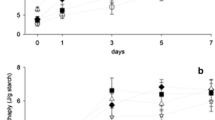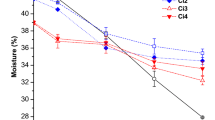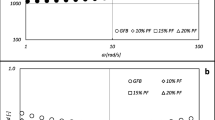Abstract
Staling indicators (texture, amylopectin retrogradation, water status and proton molecular mobility) in a high-gluten bread (25% flour substitution and water absorption at 500 Brabender Unit) were compared to a control during 1 week of storage. The contribution of macroscopic crumb to crust water migration on frozen water, molecular mobility and retrograded amylopectin was evaluated in bread loaves and bread crumb stored in NMR tubes. High-gluten bread was softer and had increased volume, cohesiveness, springiness, moisture and frozen water contents than the control, with comparable amylopectin retrogradation. An increased proton molecular mobility was observed in fresh high-gluten bread. In condition of no occurrence of macroscopic water migration, proton molecular mobility indicated reduced changes in breads during storage, suggesting the important role played by migration in the staling process. These changes were further reduced in the high-gluten bread, indicating an influence of the larger moisture content but also a contribution of gluten in regulating molecular changes.






Similar content being viewed by others
References
Vodovotz Y, Vittadini E, Sachleben JR (2002) Use of 1H cross-relaxation nuclear magnetic resonance spectroscopy to probe the changes in bread and its components during aging. Carbohydr Res 337:147–153
Gray JA, Bemiller JN (2003) Bread staling: molecular basis and control. Compr Rev Food Sci Food 2:1–21
Sereno NM, Hill SE, Mitchell JR, Scharf U, Farhat IA (2007) In: Farhat IA, Belton PS, Webb GA (eds) Magnetic resonance in food science: from molecules to man. RSC Publishing, Cambridge
Bosmans GM, Lagrain B, Ooms N, Fierens E, Delcour JA (2013) Biopolymer interactions water dynamics and bread crumb firming. J Agric Food Chem 61:4646–4654
Curti E, Carini E, Tribuzio G, Vittadini E (2014) Bread staling: effect of gluten on physico-chemical properties and molecular mobility. LWT Food Sci Technol 59:418–442
Fadda C, Sanguinetti AM, Del Caro A, Collar C, Piga A (2014) Bread staling: updating the view. Compr Rev Food Sci Food 13:473–492
D’Appolonia BL, Morad MM (1981) Bread staling. Cereal Chem 58:186–190
Hallberg LM, Chinachoti P (2002) A fresh perspective on staling: the significance of starch recrystallization on the firming of bread. J Food Sci 67:1092–1096
Baik MY, Chinachoti P (2001) Effects of glycerol and moisture gradient on thermo-mechanical properties of white bread. J Agric Food Chem 49:4031–4038
Vodovotz Y, Hallberg L, Chinachoti P (1996) Effect of aging and drying on thermomechanical properties of white bread as characterized by dynamic mechanical analysis (DMA) and differential scanning calorimetry (DSC). Cereal Chem 73:264–270
Engelsen SB, Jensen MK, Pedersen HT, Norgaard L, Munck L (2001) NMR-baking and multivariate prediction of instrumental texture parameters in bread. J Cereal Sci 33:59–67
Baik MY, Chinachoti P (2002) Effects of glycerol and moisture redistribution on mechanical properties of white bread. Cereal Chem 79:376–382
Chiavaro E, Vittadini E, Musci M, Bianchi F, Curti E (2008) Shelf-life stability of artisanally and industrially produced durum wheat sourdough bread (“Altamura bread”). LWT Food Sci Technol 41:58–70
Willhoft EMA (1971) Bread staling II. Theoretical study. J Sci Food Agric 22:176–180
Kim SK, D’Appolonia BL (1977) Bread staling studies. I. Effect of protein content on staling rate and bread crumb pasting properties. Cereal Chem 54:207–215
Martin ML, Zeleznak KJ, Hoseney RC (1991) A mechanism of bread firming. I. Role of starch swelling. Cereal Chem 68:498–503
Callejo MJ, Gill MJ, Rodriguez G, Ruiz MV (1999) Effect of gluten addition and storage time on white pan bread quality: instrumental evaluation. Eur Food Res Technol 208:27–32
Every D, Gerrard JA, Gilpin MJ, Ross M, Newberry MP (1998) Staling in starch bread: the effect of gluten additions on specific loaf volume and firming rate. Starch-Stärke 50:443–446
Wang X, Choi SG, Kerr WL (2004) Water dynamics in white bread and starch gels as affected by water and gluten content. LWT Food Sci Technol 37:377–384
Curti E, Bubici S, Carini E, Baroni S, Vittadini E (2011) Water molecular dynamics during bread staling by nuclear magnetic resonance. LWT Food Sci Technol 44:854–859
Curti E, Carini E, Bonacini G, Tribuzio G, Vittadini E (2013) Effect of the addition of bran fractions on bread properties. J Cereal Sci 57:325–332
AACC International Approved Methods of Analysis, Method 54-21.02 (2011) Rheological behavior of flour by farinograph, constant flour weight procedure. AACC International, St. Paul, MN, USA. doi:10.1094/AACCIntMethod-54-21.02
AACC International Approved methods of analysis, Method 10-05.01 (2001) Guidelines for measurement of volume by rapeseed displacement. AACC International, St. Paul, MN, USA. doi:10.1094/AACCIntMethod-10-05.01
Le Grand F, Cambert M, Mariette F (2007) NMR signal analysis to characterize solid, aqueous, and lipid phases in baked cakes. J Agric Food Chem 55:10947–10952
Prihoda J, Bushuk W (1971) Note on the effect of vital gluten on some rheological properties of dough. Cereal Chem 48:717–720
Robertson GH, Cao TK (2001) Farinograph responses for wheat flour dough fortified with wheat gluten produced by cold-ethanol or water displacement of starch. Cereal Chem 78:538–542
Codina GG, Bordei D, Paslaru V (2008) The effects of different doses of gluten on rheological behaviour of dough and bread quality. Rom Biotechnol Lett 13:37–42
Ribotta PD, Le Bail A (2007) Thermo-physical assessment of bread during staling. LWT Food Sci Technol 40:879–884
Baik MY, Chinachoti P (2000) Moisture redistribution and phase transitions during bread staling. Cereal Chem 77:484–488
Ottenhof MA, Farhat IA (2004) The effect of gluten on the retrogradation of wheat starch. J Cereal Sci 40:269–274
Eliasson AC (1983) Differential scanning calorimetry studies on wheat starch-gluten mixtures. I. Effect of gluten on the gelatinization of wheat starch. J Cereal Sci 1:199–205
Eliasson AC (1983) Differential Scanning Calorimetry studies on wheat starch–gluten mixtures. II. Effect of gluten and sodium stearoyl lactylate on starch crystallisation during ageing of wheat starch gels. J Cereal Sci 1:207–213
Slade L, Levine H (1989) Food polymer science approach to starch gelatinization and retrogradation. In: Millane RP, BeMiller JN, Chandrasekaran R (eds) Frontiers in carbohydrate research. Elsevier Applied Science, London
Levine H, Slade L (1990) Influences of the glassy and rubbery states on the thermal, mechanical, and structural properties of doughs and baked products. In: Faridi H, Faubion JM (eds) Dough rheology and baked product texture. Van Nostrand Reinhold, New York
Farhat IA, Ottenhof MA, Marie V, De Bezenac E (2003) In: Belton PS, Gil AM, Webb GA, Rutledge D (eds) Magnetic resonance in food science: latest developments. RSC Publishing, London
Curti E, Carini E, Tribuzio G, Vittadini E (2015) Effect of bran on bread staling: physico-chemical characterization and molecular mobility. J Cereal Sci 65:25–30
Imberty A, Buléon A, Tran V, Perez S (1991) Recent advances in knowledge of starch structure. Starch/Stärke 43:375–384
Acknowledgements
This work was partially supported by Emilia-Romagna Region (POR FSE, 2007–2013).
Author information
Authors and Affiliations
Corresponding author
Ethics declarations
Conflict of interest
Carini, Curti and Vittadini declare that they have no conflict of interest.
Compliance with ethics requirements
This article does not contain any studies with human or animal subjects.
Rights and permissions
About this article
Cite this article
Curti, E., Carini, E. & Vittadini, E. Staling and water dynamics in high-gluten bread. Eur Food Res Technol 243, 1173–1182 (2017). https://doi.org/10.1007/s00217-016-2832-8
Received:
Revised:
Accepted:
Published:
Issue Date:
DOI: https://doi.org/10.1007/s00217-016-2832-8




